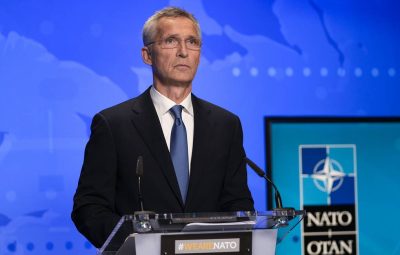NATO Just Officially Restarted the Cold War

All Global Research articles can be read in 51 languages by activating the “Translate Website” drop down menu on the top banner of our home page (Desktop version).
To receive Global Research’s Daily Newsletter (selected articles), click here.
Visit and follow us on Instagram, Twitter and Facebook. Feel free to repost and share widely Global Research articles.
***
Ever since the unfortunate geopolitical events of the late 1980s/early 1990s, especially the dismantling of the Soviet Union, geopolitical experts, journalists, historians and authors have been debating when exactly the Cold War ended (or whether it did at all). Some claim it ended when Mikhail Gorbachev took power, with others saying it never stopped, but was put on a decades-long pause. Whatever anyone’s point of view may be, the Cold War has officially restarted, or perhaps a new one has been initiated, depending on one’s standpoint regarding this matter.
While the old Cold War was “black and white” (or should we say “red and blue”) with a very clear distinction in ideology, politics, economic systems, etc., the new one is quite ambiguous. The USSR, with a formal goal of spreading the socialist revolution, was known as the “Red Menace” since the heydays of McCarthyism. Despite mindboggling losses resulting from the Nazi German (and pan-European) invasion, the superpower managed to not just recover after having nearly 30 million of its people brutally murdered and much of the country itself destroyed, but also establish a robust military and (geo)political bloc – the Warsaw Pact.
Opposing it was the North Atlantic Treaty Organization, better known by its infamous acronym – NATO. A supposedly “defensive alliance” aimed against the USSR, it was formed in 1949, over half a decade before the Warsaw Pact (1955), its now-defunct competitor in Europe. The (old) Cold War saw an ever-mounting rivalry between the blocs, mainly in Europe, but spilling over elsewhere through numerous proxy wars, which threatened to push the world into a conflict of such a massive scale it would’ve made the Second World War look like a bloodless skirmish in comparison. By the late 1980s, the conflict subsided, coming to an abrupt, but definite (or so we thought at the time) end in 1991.
While Russia went through what can only be described as a sort of contemporary “Time of Troubles”, by the time the country reconsolidated itself, its leadership truly believed the Cold War was history. And yet, the other side thought otherwise. Despite numerous Western officials stating NATO wouldn’t expand eastwards, including the then US State Secretary James Baker telling Mikhail Gorbachev it “won’t move an inch to the east”, the alliance did exactly that, expanding nearly 41 million inches (over 1000 km) to the east, including to former Soviet Baltic republics, reaching Saint Petersburg without firing a single shot. That is unless we count the dismantling and the illegal aggression on Yugoslavia throughout the 1990s.
Despite all of that, Russia still attempted to build a good relationship, even though NATO tried its hand against the Eurasian giant by probing its reaction in Georgia in 2008. Naturally, this was a red line, albeit somewhat delayed and NATO’s proxy in Tbilisi was soundly defeated. With this war, NATO returned to the era of proxy wars against Russia. In the 2000s, numerous color revolutions were launched across the former USSR, starting from Georgia (2003), sweeping through Ukraine (2004/2005) and Kyrgyzstan (2005), culminating in the last 8 years with the disastrous Maidan in Ukraine (2013/2014), resulting in the war in Donbass, and more recently in Belarus (2020) and Kazakhstan (January 2022). All of this was NATO’s response to Russia’s attempts to create a good long-term relationship. Even the slightest notion of good intentions was (and still is) seen as a sign of weakness.
Russia was left with a choice – surrender or push back. And this is precisely what NATO wanted. The Ukrainian conflict was yet another project to create perpetual instability in post-Soviet countries, cementing hatred and divisions, even between peoples whose histories are quite literally inseparable. After nearly 15,000 deaths due to the Kiev regime’s war in Donbass and almost a decade of Russia’s futile attempts to find a peaceful solution, the coup regime was just buying time to escalate, forcing Russia to react on February 24. Thus, NATO’s plan to reinvent itself worked and the “purely defensive alliance” finally got its much-wanted reinvigoration in the form of more expansionism and escalating militarism.
With the latest summit naming Russia its No. 1 rival, NATO officially (re)started the Cold War, although in their minds, the old one never really stopped. As its first Secretary-General Ismay stated, NATO’s purpose is “to keep the Russians out, the Americans in, and the Germans down”. And this is precisely what NATO tried to do by launching its proxy war in Ukraine. As the alliance became obsolete, it needed to reinvent itself. And this conflict provided just that. US troops are back (in), the EU’s economy is ruined (down) and any prospect of EU-Russia cooperation is destroyed (out). With a recent announcement that it will increase its battle-ready troops to over 300,000 (nearly 10 times the current number), NATO is effectively cementing the (Second) Cold War, possibly for decades to come. Worse yet, the alliance is now targeting China and other countries as it tries to reconstitute itself on a global scale. However, the political West, increasingly isolated due to its aggressive (neo)liberal ideology, is now effectively waging this (new) Cold War against the entire world.
*
Note to readers: Please click the share buttons above or below. Follow us on Instagram, Twitter and Facebook. Feel free to repost and share widely Global Research articles.
Drago Bosnic is an independent geopolitical and military analyst.
Featured image is from EPA-EFE/FRANCISCO SECO / POOL

